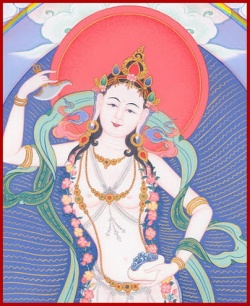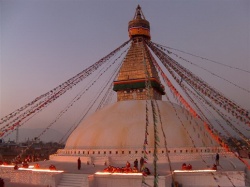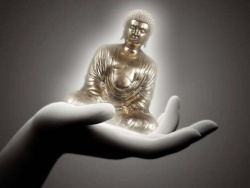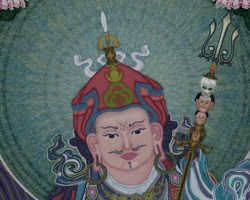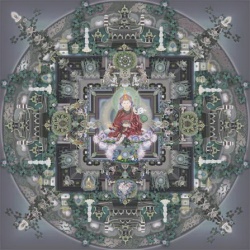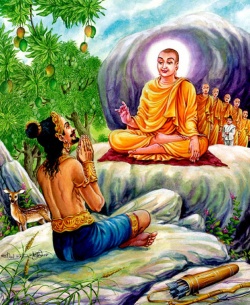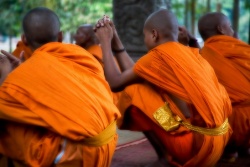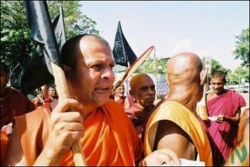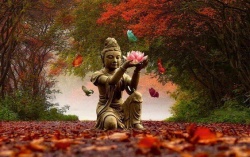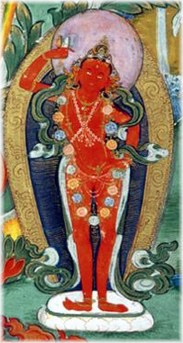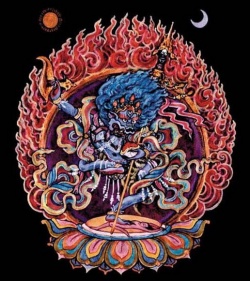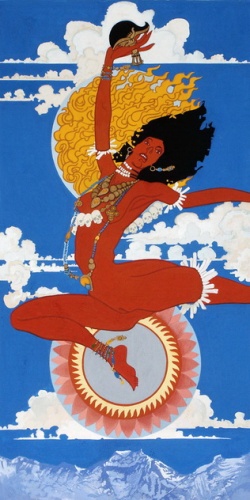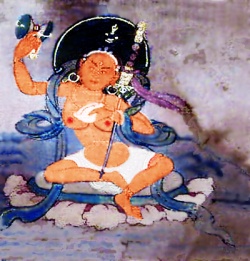Dakini
Click here to see other articles relating to word Dakini

A dakini (Sanskrit: डाकिनी ḍākinī; Standard Tibetan: མཁའ་འགྲོ་མ་ khandroma, Wylie: mkha' 'gro ma, TP: kanzhoima; Chinese: 空行母) is a tantric figure designated as a female embodiment of enlightened energy.
In the Tibetan language, dakini is rendered khandroma which translates as 'she who traverses the sky' or 'she who moves in space'. Sometimes the term is translated poetically as 'sky dancer' or 'sky walker'.
The dakini is so central to the requirements for a practitioner to attain full enlightenment as a Buddha that she appears in a tantric formulation of the Buddhist Three Jewels refuge formula known as the Three Roots.
Most commonly she appears as the protector, alongside a guru and yidam, but Judith Simmer-Brown points out that:
- The dakini, in her various guises, serves as each of the Three Roots. She may be a human guru, a vajra master who transmits the Vajrayana teachings to her disciples and joins them in samaya commitments.
The wisdom dakini may be a yidam, a meditational deity; female deity yogas such as Vajrayogini are common in Tibetan Buddhism.
Or she may be a protector; the wisdom dakinis have special power and responsibility to protect the integrity of oral transmissions.
As a key tantric figure the dakini also appears in other forms of tantric Buddhism such as the Japanese Shingon school from where she disseminated into Japanese culture, evolving into Dakini-ten and becoming linked to the kitsune iconography.
The origins of the dakini symbol are uncertain but she continues to this day as a part of Indian folklore, generally in wrathful forms, and remains a part of Hindu tantra.
In Tibetan Buddhism
Although dakini figures appear in Hinduism and in the [[Bön] tradition]], dakinis occur most notably in Vajrayana Buddhism and play a particular role in Tibetan Buddhism.
There the dakini, generally of volatile or wrathful temperament, acts somewhat as spiritual muse (or inspirational thought forms) for spiritual practice. Dakinis are energetic beings in female form, evocative of the movement of energy in space.
In this context, the sky or space indicates shunyata, the insubstantiality of all phenomena, which is, at the same time, the pure potentiality for all possible manifestations.
Classes of Dakini
Judith Simmer-Brown, based on teachings she received from Tibetan lamas, identifies four main classes of dakini.
These follow the Twilight Language tradition of esotericism in referring to secret, inner, outer and outer-outer classes of dakinis.
- The secret class of dakini is Prajnaparamita (Tibetan yum chenmo) or voidness, the empty nature of reality according to Mahayana doctrine.
- The inner class of dakini is the dakini of the mandala, a meditational deity (Tibetan:yidam) and fully enlightened Buddha who helps the practitioner recognise their own Buddhahood.
- The outer dakini is the physical form of the dakini, attained through Completion Stage Tantra practices such as the Six Yogas of Naropa that work with the subtle winds of the subtle body so that the practitioner's body is compatible with an enlightened mind.
- The outer-outer dakini is a dakini in human form. She is a yogini, or Tantric practitioner in her own right but may also be a kamamudra, or consort, of a yogi or mahasiddha.
Dakinis can also be classified according to the Trikaya, or [[three bodies of a [Buddha]].
- The Dharmakaya dakini, which is Samantabhadri, represents the Dharmadhatu where all phenomena appear.
- The Sambhogakaya dakinis are the yidams used as meditational deities for tantric practice.
- The Nirmanakaya dakinis are human women born with special potentialities; these are realized yogini, the consorts of the gurus, or even all women in general as they may be classified into the Five Buddha Families.
In Dzogchen
When considered as a stage on the Vajrayana Path, the dakini is the final stages:
the first is the guru, which corresponds to the initial realization of the true condition of reality, as this is introduced by the guru in the empowerment, if the disciple obtains what the Inner Tantras call peyi yeshe (dpe yi ye shes) o the clarity of shunyata.
The second is the devata, which corresponds to the meditation insofar as the devata is the method used for developing the state discovered in the initial realization of the true condition of reality.
The third stage is the dakini insofar as the dakini is the source of the activities based on the realization of the guru and the meditation of the devata.
In Dzogchen these three correspond to tawa (lta ba), gompa (sgom pa) and chöpa (spyod pa): the first is the direct vision of the true nature of reality rather than an intellectual view of reality, as is the case with the term in other vehicles;
the second is the continuity of this vision in sessions of meditation; and the third is the continuity of this vision in everyday activities. As a tantric practice, imperfections are utilised to make the vision uninterrupted.
As the Base, the dakinis are the energies of life;
as the Path, they are the activities of advanced practitioners; as the Fruit, they are the actionless activities of realized Masters.
In Anuttarayoga Tantra
Being associated with energy in all its functions, dakinis are linked with the revelation of the Anuttarayoga Tantras, which represent the path of transformation, whereby the energy of negative emotions or kleshas, called poisons, is transformed into the luminous energy of enlightened awareness yielding the most profound experience of clear light.
Thubten Yeshe explains:
- When the completion stage practices have been mastered and we have gained control over our subtle energy winds and so forth, there will come a time when the dakas and dakinis will come... physically embracing such a consort is ncessary for bring all the pervading energy winds into the central channel, a prerequisite for opening the heart center and experiencing the profoundest level of clear light.
In Hinduism
In Hinduism the term dakini often has negative associations although in Hindu tantrism dakinis are the guardians of the deeper mysteries of the self, through whom the secrets of inner transformation are revealed.
There is a distinction between terms such as shakti, yogini, shakini and dakini, although in general conversation it is often blurred and the terms used interchangeably.
For example Rajaram Narayam Saletore records that in Bengal a shakini is a type of witch that may be called a dakini in other parts of the country.
According to one legend Dakini and Shakini were the wives of Tripurasura.
After Tripurasura was slain by Shiva, they received the boon from Shiva, that they could live in the forest without any threat and people would have to chant their names before they could visit the shrine of Bhimashankara.
Hence the forest around there became known as Dakini Forest.
In Hindu Tantra, practices such as Tantric sex may involve a "helper" dakini – a human female trained in tantric yoga – or even an "actual" dakini.
In Hinduism, persons seeking siddhi, or powers, such as yogis often have to face challenges from dakini, shakini and other wrathful or semi-wrathful female figures.
They have to be defeated or overcome in order to gain siddhi and thus become a Mahasiddha or a true yogii, with control over the elements of nature.
There are many mantra and strota in Hindu scripture that are believed to defeat or get protection from dakini, shakini and others.
The chief deity who has control over dakinis and so forth is Hanuman.
The Vichitra Veer Hanuman Stroram, sung in praise of Vichitra Veer Hanuman, a ferocious form of Hanuman, details the negative elements over whom Hanuman has control, including dakini.
There are many other Hanuman mantras to win over a dakini.among which famous ones are Panchamukhi Hanuman Kawacham and Saptamukhi Hanuman Kawacha.
Hindus also recite Sri Sudarshana Kawacha, a Sanskrit shloka or kawacha sung in praise of Vishnu and named after his weapon Sudarshana Chakra to get protection or dispel dakinis and others. and Devi Kavacham sung in praise of Durga
Dakini, Shakini, Kakini, Kamini are as per Hindu tantra also the shaktis or power who control the different Chakras. Thus dakinis are the guardians of the deeper mysteries of the self, and it is through them that the secrets of inner transformation are opened.
Once a person is able to awaken Kundalini and move it from its base, Muladhara to top Sahastradhar, he becomes a Yogi.
In Japanese Buddhism
Although the dakini imagery appears to have come to Japan via Kukai's introduction of tantric Buddhism in the Shingon school in the early 9th century, her form appears more like the dakinis of Hindu iconography than those found in the Tantra of Tibetan Buddhism, the other main surviving school of tantric Buddhism.
During the decline of the Heian period, the dakini image was mixed together with images of foxes and half-naked women, acquiring the names Dakini-ten (Dakini-deity, 荼枳尼天), Shinkoō-bosatsu (Central Fox Queen-Bodhisattva, 辰狐王菩薩), and Kiko-tennō (Queen, 貴狐天王).
In the Middle Ages the Emperor of Japan would chant before an image of the fox Dakini-ten during his enthronement ceremony, and both the shogun and the emperor would pay honors to Dakini-ten whenever they saw it.
It was a common belief at the time that ceasing to pay respects to Dakini-ten would cause the immediate ruin of the regime. Although Dakini-ten was said to be a powerful Buddhist deity, the images and stories surrounding it in Japan in both medieval and modern times are drawn from local kitsune mythology.
The modern folk belief, often printed in Japanese books about religion, is that the fox image was a substitute for the Indian jackal, but the jackal is not associated with Dakini anywhere.
As another example of the connection between Dakini-ten and the government of Japan, in the Genpei Jōsuiki it is claimed that Taira no Kiyomori met a kitsune on the road and that his subsequent performance of Dakini-ten rites caused him to rise from an unimportant clan leader to the ruler of the entire nation.
In early modern times the Dakini rite devolved into various spells called Dakini-ten, Izuna, and Akiba.
People who felt wronged in their village could go to a corrupt yamabushi who practiced black magic, and get him to trap a kitsune and cause it to possess a third party.
Reports of possession became especially common in the Edo and Meiji periods. For details, see kitsunetsuki.
Associations with Other Cultures
In Iranian Themes in Tibetan Tantric Culture: The Ḍākinī, David Templeman points out the links between dakinis as found in Tibetan Buddhism and Urgyen which is in what is now Northern Pakistan.
He suggests that this links the wrathful dakinis to another form of wrathful female, the Persian peri.
Daka
There is some disagreement amongst Western scholars as to the meaning of the term daka.
Some see it as the same as a dakini but in its male embodiment, and thus to be the partner of a female practitioner or yogini, or identify a daka as the consort of a dakini.
However in consort yoga, the consort of a dakini is a yogi.
For example, the most famous instance of consort yoga in Tibetan tantra involved its founder, the Indian Mahasiddha Padmasambhava and Yeshe Tsogyal, a Tibetan princess and yogini.
Padmasambhava was known as a yogi and Yeshe Tsogyal as a dakini.
Miranda Shaw, associate professor of religion at University of Richmond, said in an interview in 1995 "In Sanskrit there is only one word, Dakini.
There are only female Dakinis... there is no male Dakini.
It is an impossibility and a contradiction in terms." Whereas Jan Willis in the chapter Ḑākinī; Some Comments on Its Nature and Meaning points out that ""she" is not "female".
Though the ḍākinī assuredly most often appears in female form... this is but one of the myriad of ways Absolute Insight chooses to make manifest its facticity"
However, Tibetan Lamas trained in the Gelug school, such as Sermey Khensur Lobsang Tharchin and Kelsang Gyatso and the Karma Kagyu school such as Khenpo Karthar Rinpoche write freely of "dakas and dakinis". Thubten Yeshe clarifies their meaning: "what are dakas and dakinis?
Simply speaking they are males and females who possess advanced experiences of tantric transformation and control and are therefore able to increase the blissful wisdom of a highly qualified practioner"
Dakini (Skt. ḍākinī; Tib. མཁའ་འགྲོ་མ་, khandroma; Wyl. mkha' 'gro ma) — a female embodiment of enlightened energy. མཁའ་འགྲོ་, ‘Khandro’ literally means ‘sky-goer’, indicating one who traverses the 'sky' of the expanse of wisdom.
Female lamas and the spiritual wives of male lamas often have the epithet 'khandro'.
dakini (kongxing-mu, khandroma): Literally, a “female sky-goer.”
Female wisdom beings who help arouse blissful energy in qualified esoteric Buddhism practitioners and who are particularly associated with the transmission of secret teachings to esoteric Buddhism practitioners.
She may be a human being who has attained high realizations of the fully enlightened mind or a non-human manifestation of the enlightened mind of ameditational deity such as a female dharma protector who is usually depicted as a wrathful or semi-wrathful form. “Vajravarahi” is the leader of the Dakinis although she is not a Dakini.
http://xuanfa.net/glossary/d/ xuanfa.net
- One of the three roots (rtsa ba gsum) of spiritual practice, along with the spiritual teacher and the meditational deity.
The ḍākinī are said to confer enlightened or buddha activities on the meditator, in contrast to the spiritual teacher who confers blessings and the meditational deity who confers accomplishments.
The ḍākinī are female yoginī who have attained either mundane or supramundane spiritual accomplishments (siddhi), the latter referring to the realisations of the fully enlightened mind (bodhicitta).
They may be human beings who have achieved such attainments, or manifestations of the enlightened activity of the meditational deity.
The Tibetan equivalent mkha' 'gro literally means 'space voyager', space metaphorically implying emptiness, and voyager indicating someone immersed in its experience. GD (from the Glossary to Tibetan Elemental Divination Paintings)
mkha' 'gro - dakini, inspirations, bird, angel, fairy, SA rin chen mkha' 'gro, god, arrow, sky-goer, possessor of spiritual daka power in male form
mkha' 'gro - (ma) - dakini; sky-goer/ dancer;
1) dakini. Syn {mkha' 'gro ma}.
2) [sometimes also both daka and dakini when {mkha' 'gro} + {mkha' 'gro ma}
3) birds.
4) devas.
5) possessor of spiritual daka power in male form,
6) a class of sky going beings.
7) goddess or female tantric deities who protect and serve the tantric doctrine.
8) daka. male space-farers or viras {dpa' bo}, celestial flight; daka; sky-goer/ dancer; goddess [sky goers], possessor of spiritual daka power in male form
mkha' 'gro - {mkha' 'gro ma} dakini; (feminine) sky goer/ dancer
mkha' 'gro skyes - "born by dakini", rakshasa
mkha' 'gro chos skyong nor lha - dakinis, Dharma protectors and wealth gods
mkha' 'gro gtad rgya - Entrusting the teachings to the dakinis; entrustment to dakinis, the dakini entrusted (terma lineage); sealed entrustment to dakinis
mkha' 'gro gtad rgya - entrustment to dakinis
mkha' 'gro gtad rgya brgyud pa - the dakini-entrusted lineage. Syn {mkha' 'gro gtad rgya yi brgyud pa}
mkha' 'gro gtad rgya'i brgyud pa - lineage of the dakinis' seal of entrustment
mkha' 'gro dam can - dakinis and loyal guardians
mkha' 'gro dam can - dakinis and oath-bound protectors
mkha' 'gro sde lnga - the five dakini aspects. Syn {mkha' 'gro ma rigs lnga} The five families.
1) rdo rje mkha' 'gro Vajra dakini.
2) rin chen mkha' 'gro Ratna dakini
3) pad ma mkha' 'gro Padma dakini
4) las kyi mkha' 'gro karma dakini
5) sangs rgyas mkha' 'gro Buddha dakini
mkha' 'gro sde bzhi - the four classes / aspects of dakinis. Syn {mkha' 'gro rigs bzhi
mkha' 'gro sde bzhi - Four classes of dakinis.
The dakinis of the four families of;
They are spiritual beings who carry out the four activities of pacifying, increasing, magnetizing, and subjugating
mkha' 'gro brda yig - dakini code script, symbolic script / writing of the dakinis
mkha' 'gro ma - dakini, dakini, an especially accomplished yogini, possessor of spiritual dakini power in female form, female space farers who embody emptiness
mkha' 'gro ma - dakini, SA chu srin mo, stag gdong can, female sprites, possessor of spiritual dakini power in female form, dakini (lion tiger {chu srin} and dragon faces associated with east, south, west and north and rdo rje, rin chen pad ma, and phrin las)
Source
ḍākinī. (T. mkha’ ’gro ma; C. tuzhini; J. dakini; K. tojini 荼枳尼). In Sanskrit, a cannibalistic female demon, a witch; in Śāntideva’s Bodhicaryāvatāra, a female hell guardian (narakapālā);
in tantric Buddhism, ḍākinīs, particularly the vajraḍākinī, are guardians from whom tāntrikas obtain secret doctrines.
For example, the Vajrabhairava adept Lālitavajra is said to have received the Yamāntaka tantras from vajraḍākinīs, who allowed him to bring back to the human world only as many of the texts as he could memorize in one night.
The ḍākinī first appears in Indian sources during the fourth century CE, and it has been suggested that they evolved from local female shamans.
The term is of uncertain derivation, perhaps having something to do with “drumming” (a common feature of shamanic ritual).
The Chinese, Japanese, and Korean give simply a phonetic transcription of the Sanskrit.
In Tibetan, ḍākinī is translated as “sky goer” (mkha’ ’gro ma), probably related to the Sanskrit khecara, a term associated with the Cakrasaṃvaratantra.
Here, the ḍākinī is a goddess, often depicted naked, in semi-wrathful pose (see Vajrayoginī); they retain their fearsome element but are synonymous with the highest female beauty and attractiveness and are enlightened beings.
They form the third of what are known as the “inner” three jewels (Ratnatraya):
the guru, the Yidam, and the ḍākinīs and protectors (Dharmapāla; T. chos skyong).
The archetypical Tibetan wisdom or knowledge ḍākinī (ye shes mkha’ ’gro) is Ye Shes Mtsho Rgyal , the consort of Padmasambhava.
Ḍākinīs are classified in a variety of ways, the most common being mkha’ ’gro sde lnga,
the female buddhas equivalent to the Pañcatathāgata or five buddha families (Pañcakula): Buddhaḍākinī (alt.
Ākāśadhātvīśvarī; Sparśavajrā) in the center of the maṇḍala, with Locanā, Māmakī, Pāṇḍaravāsinī, and Tārā in the cardinal directions.
Another division is into three: outer, inner, and secret ḍākinīs.
The first is a Yoginī or a Yogin’s wife or a regional goddess, the second is a female buddha that practitioners visualize themselves to be in the course of tantric meditation, and the last is nondual wisdom (Advayajñāna).
This division is also connected with the three bodies (Trikāya) of Mahāyāna Buddhism:
the Nirmāṇakāya (here referring to the outer ḍākinīs),
Saṃbhogakāya (meditative deity), and
the Dharmakāya (the knowledge ḍākinī).
The word ḍākinī is found in the title of the explanation (vākhyā) tantras of the yoginī class or mother tantras included in the Cakrasaṃvaratantra group.
Source
The Princeton Dictionary of Buddhism by Robert E. Buswell Jr. and Donald S. Lopez Jr.
